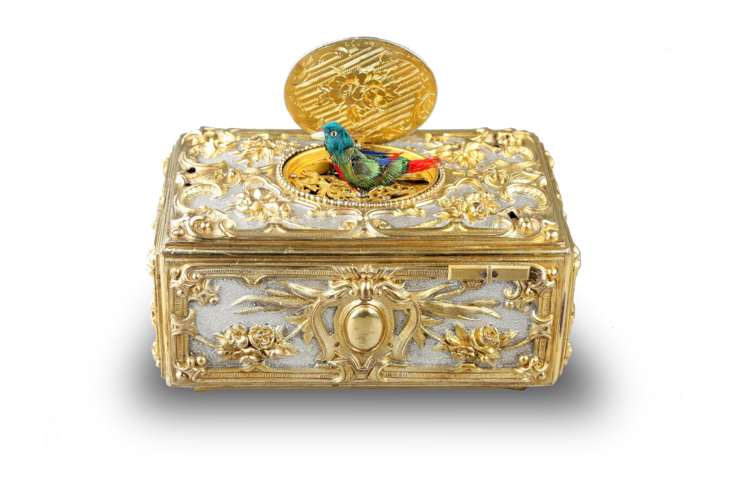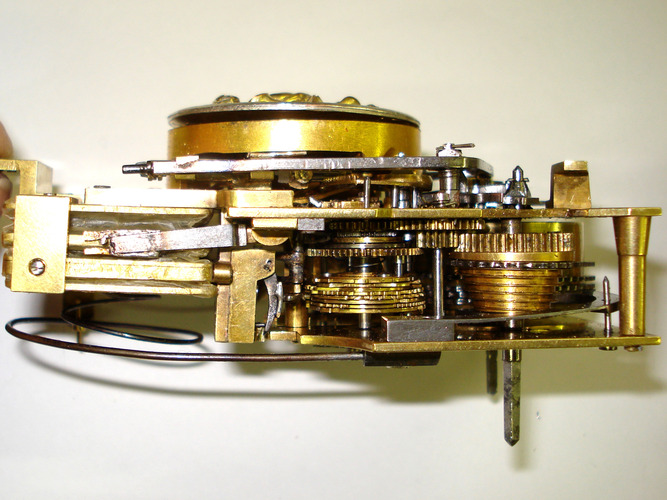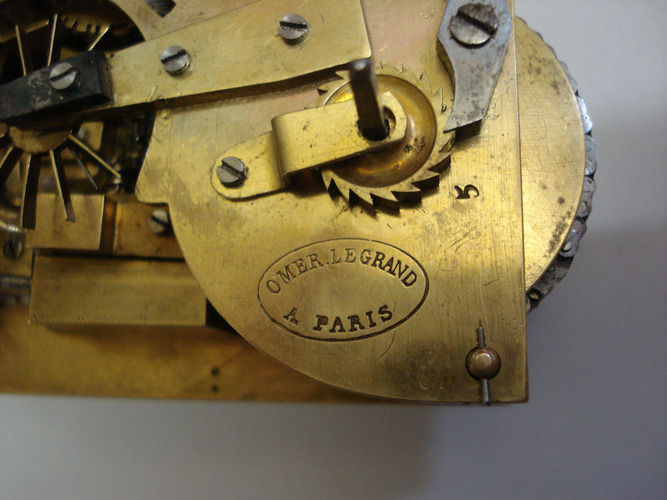
Antique Fusee Singing Bird Box by Omer LeGrand
A highly important and fine antique veri-gilt and platinum singing bird box, by Auguste-Omer Legrand
French
pre-1849
Unique fusee movement,
The rarest of offerings from the man who was sued by Robert Houdin,
When wound and the start/stop slide actuated, the bird lid opens as the bird suddenly hones into view, flapping both wings, bobbing tailfeather, turning whole body from side-to-side and opening and closing beak in perfect synchronicity to highly unusual continuous lengthy birdsong from the eight cam stack, directed by sprung clutch to two-forward and one-back cycle.
The movement suspended from top plate, with massive spring barrel and heavy-gauge chain, bellows pumping cam unusually driven directly from first endless gear train, bird lid lever pivoted from start rod and lowered by gravity instead of multiple run-down train, and melody containing phrases which are familiar to cams within Bontems movements. Layout of the key working modules generally of a different nature to any other singing bird box.
Bottom plate stamped clearly with Omer Le Grand within oval.
The bird with multi coloured feathered plumage with bright undertone flashes and naturalistic beak, rising up through the pierced and tooled highly gilt grille, in the sublime high-Rococo style case of the most magnificent colour and execution. Of larger proportions and of heavy weight, this imposing case has the bird lid with relief tri-colour gilt toned musical instrument ensemble, centred to the main lid which has much raised detail of scrolls and joined intermediate geometric matrix and banners, all richly toned in a minimum 15kt gilt against the equally bright platinum ground with dimpled texture running to the entire frame of the top, sides and underside. All with the matching gilt raised chase-work to achieve the full enrobed form.
The underside corner scrolls raised a micron higher to form the four feet for support, the suspended movement screws just visible inset to main top, start/stop front-right and winding spindle off-set to underside corner.
Presented and preserved in this stunning condition in the period travelling case with cream velvet interior and black leather covered exterior, with a T bar key in polished steel and brass.
size -
Reference and further reading -
Gazette Des Tribunaux, Paris Edition, Wednesday 26th June 1850.
Point of Interest -
Auguste Omer Legrand is remembered after 1850 for all the wrong reasons.
A skilled clockmaker, he successfully designed and built a number of pieces before being taken on by Robert Houdin to work within the walls of his world class theatre in the Palais Royale, Paris, as part of the team who helped to design and build the exhibits of magic and wonder. The work and skills Legrand was capable of would have been at a standard which impressed Houdin, and it is thought few would have stepped up to this. Although an employee of Houdin, Legrand continued to sell his own wares to clients in Europe and elsewhere,...or so Houdin thought.
Until November 1849, all was well professionally with the Houdin-Legrand relationship. But then Houdin found out that a special crystal safe to Houdin's own specifications had found its way into the hands of Englishman Mr. Lettson, who at the time was attached to the British Embassy in Turin. It had been marketed and sold under Legrand's name. It was later found that this was not the first time Legrand had sold something belonging to Houdin to this particular individual.
Furious with this deception but not legally inclined to take it further, Houdin quickly fired Legrand citing this deception unacceptable. But what Houdin didn't realise was that this was the thin edge of the wedge.
For some time, it turned out Legrand had made parts and whole unit modules from plans and drawings Houdin had executed and sold them on the side to other clients, some of which may have been rivals to Houdin - revealing the intricacies and secrets of the movements which only paying audiences saw as magic. He had also removed, without immediate detection, parts to whole movements actually made by Houdin and taken them back home.
Under investigation, a visit to his home proved Legrand was up to no good as they stumbled across many parts and movements which had been taken without authorisation.
Arrested, he was charged with fraudulently taking a diverse number of mechanical parts to his house and to the prejudice of Robert Houdin, for whom he was a workman. And to have , in 1848 and 1849, being a factory worker, communicated to strangers (including Lettson), secrets of the factory of Robert Houdin, for whom he was employed. These were crimes under articles 386 and 418 of the Penal Code.
The court case which followed was a bit of a teaser for members of the public gallery including press. According to the post verdict review, the evidence in the form of box after box filled with movements, mechanisms and parts, most of which found on Legrand's premises, laid on the floor in the middle of the room, covered by a sheet. When the stage of the proceedings got to the point of evidence examination, this was done behind closed doors. Houdin's magical secrets for which were essential to the core policy of his theatre continued to be protected and Houdin made clear in a statement which followed, that his wish to have his day in court was not done for publicity reasons.
Perhaps they were, perhaps they weren't; we will never know, but as his theatre was mentioned, he may have seen an increase in attendance thereafter.
The post-case review in the Gazette Des Tribunaux carefully details the case and the people involved, but to summarise, Legrand was found guilty and sent to prison for two years and made to pay all costs. Robert Houdin got back the seized movements and parts found at Legrand's property.
The 1850 conviction and his subsequent imprisonment for, what would be classed today as theft, handling stolen property and patent misuse, will be seen by many if not all as a clear picture drawn of a man whose intentions most probably started off as being honourable, but whose thirst for money and prestige got the better of him. He could so easily have become Houdin's right-hand man, and been part of the inner 'magic circle' of the theatre Houdin ran in Paris.
But alas, it was not to be. Bearing in mind Robert Houdin's business at the time, compared to some of todays amazing 'palaces of entertainment', he probably got off pretty lightly.
Despite the obvious motives of Legrand whilst working for Houdin were personal enterprise (he would have been caught out eventually), it's clear that he had a very dedicated and advanced mind in the handling of design theory; however he seemed to have had problems working out basic ideas through to finished fruition. Perhaps a genuine idea was there in mind, but he struggled to convince his hands to complete to task. Therefore, he had to take from others who had already got there.
As he acquired, by unorthodox means, the parts, or modules, which made each process of a signing bird box possible, he had to figure out a way of getting them all to work together. We can come to no other conclusion but to suggest that not all design patterns within this piece are his own, and this theory is certainly backed up when examining the movement in very close detail. The conclusion is that no one would have designed this movement in one go, purely because the efficiency factor is questionable. Almost an experimental movement, several areas work and mesh awkwardly, but to be fair, it does work, but with the helping hand of a much stronger spring than usual, in order to turn the increased load through from start to finish. Coupled with a fusee chain of nearly twice the usual thickness and grade, thicker fusee wheel spindle and spring barrel, makes for a chunkier proportion overall between the movement plates and the case and overall weight is greater too.
This singing bird box movement has cams of great interest. The phrase heard in the middle section is almost exactly the same as the first few bars of the very popular birdsong score Bontem and Griesbaum were using in the 1890-1950 period - Were they copying Legrand in a fit of amusing coincidence? If so, this would be the very first singing bird box whose cams are cut with this song. The 'studio master'.
This exceptionally rare piece, stamped by Legrand, gives us the very first insight into the workings of not just a singing bird box with a unique movement, but the workings of the mind of a man who was, like Houdin, unique as well.
Not seen before, this museum piece tells and demonstrates a very important story. As well as being a solo branch on the singing bird box design tree, the man behind its creation must be mentioned as part of the whole picture.
Houdin was a genius, whilst Legrand could have been.
| STOCK No | 1421 |
| AVAILABILITY | Sold |
| PRICE | Sold |









































